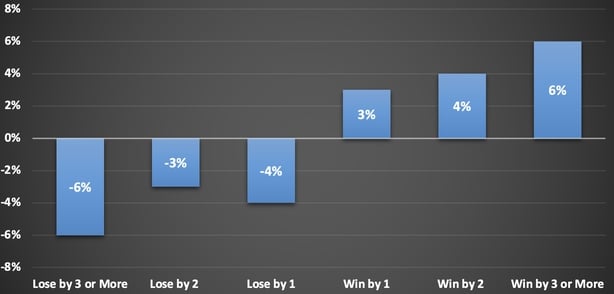Analysis: The night owl effect means home teams are nearly 15% more likely to win games with later kick-offs compared to early kick-offs
Is there a night owl effect in operation in the Premier League? I analysed all the fixtures in the English Premier League's 2021/2022 season and kept finding that home teams are significantly more likely to win fixtures during late kick-offs compared to early kick-offs. So why is this the case?
For a start, later kick-off times may mean lower levels of support for the away team. There is generally lower demand for later kick-offs. This is particularly the case for away fans who may have to travel long distances to attend football matches or even pay for accommodation if a return journey on match day isn’t feasible.
We need your consent to load this rte-player contentWe use rte-player to manage extra content that can set cookies on your device and collect data about your activity. Please review their details and accept them to load the content.Manage Preferences
From RTÉ Radio 1's Drivetime, Dr Daragh O'Leary discusses the night owl effect on Premier League kick-off times (discussion begins at 24.40)
Later kick-off times might also create more hostile environments for away teams to play in. Alcohol consumption is common among Premier League spectators and has been known to increase aggressive or violent behaviour. Given that drinking is typically considered a part of the night-time economy, it could be reasoned that later kick-off times better facilitate alcohol consumption among fans which makes for a more hostile atmosphere that intensifies home advantage.
There are normally 10 fixtures a week throughout the course of a Premier League season. Fixtures are typically played at weekends with Saturday, Sunday, and Monday (or Friday) fixtures. Saturday fixtures generally kick-off at 12/12.30pm, 3pm and 5.30pm, while Sunday games will typically kick-off at 2pm or 4pm. Friday and Monday night fixtures typically kick-off at 7.30pm, 7.45pm or 8pm.

As can be seen above, the most common kick-off time in the Premier League is the middle-of-the-day kick-off (59.47%) followed by late (32.37%) and early (8.16%) kick-offs. Interestingly, kick-off times are not evenly allocated to teams. Fixtures which involve the traditional Big Six (Arsenal, Chelsea, Liverpool, Manchester City, Manchester United and Tottenham Hotspur) are less likely to be allocated middle-of-the-day fixtures. While roughly 60% of Premier League matches are middle-of-the-day fixtures, less than 50% of Premier League matches featuring the Big Six are middle-of-the-day fixtures.
This is presumably because most of these fixtures cannot be televised due to the broadcasting blackout time in the UK from 2.45pm and 5.15pm on Saturdays. Accordingly, the Premier League allocates big clubs more early and late kick-off times so that they can be broadcasted.
While this makes sense from a business perspective, it does mean there is an imbalance in the allocation of kick-off times between teams. Unfortunately for the Premier League, my research indicates that this may impact competitive balance among teams. Not only are home teams more likely to win late kick-offs, they are also more likely to win them by greater margins.

Home teams are 6% more likely to win a fixture by three or more goals if the fixture is a late kick-off (after 4.30pm) compared to an early kick-off (12/12.30pm). Additionally, late kick-offs also reduce the likelihood that away teams will keep a clean sheet by just over 26%.
It should be noted that these results also account for other factors which may influence the result of a Premier League fixture. Relative fixture difficulty and red cards picked up by the home team are still two of the most influential factors associated with impacting a fixture. But even after controlling for fixture difficulty, attendance, red cards, relative age of teams, distance between teams, and the time of the season, home teams still seem to have an advantage depending on whether the game is played later in the day.
So what does this all mean for the Premier League? The League operates a double round robin format where each team plays each other twice (once home, once away). Generally, the sports economics literature would view this as a fair format given that the number of home and away games each team has to play is the same.
From The Guardian, what are the challenges facing away fans in the age of televised football?
But this analysis finds evidence of a night owl effect where home advantage becomes intensified during later kick-off times. Unless each fixture takes place at the exact same time, some teams' home advantage may be greater than others. This may explain why cold rainy nights in Stoke are so difficult for away teams and why punters often refrain from backing early kick-offs because they produce unusual results.
Theoretically, the night owl effect could be removed by playing all fixtures at the same time. In reality, this may not be possible (or advisable) due to logistical and broadcasting issues. However, the Premier League could consider significantly reducing the variation between kick-off times to mitigate against night owl effects. For example, spreading fixtures out over a week rather than a weekend would allow the level of variation between kick-off times to be reduced and minimise the uneven influence of night owl effects. Weekend fixtures could be prioritised for clubs playing in European competitions midweek.
Follow RTÉ Brainstorm on WhatsApp and Instagram for more stories and updates
The views expressed here are those of the author and do not represent or reflect the views of RTÉ







